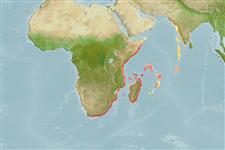Environment: milieu / climate zone / depth range / distribution range
Οικολογία
Θαλασσινό(ά); Γλυκού νερού; Υφάλμυρο βενθικό(ς); κατάδρομος (Ref. 51243). Tropical; 25°N - 35°S
Western Indian Ocean: east coast rivers of Africa from Kenya south to Cape Agulhas, also in Madagascar and other western Indian Ocean islands (Ref. 7248, 52193). Reported from New Caledonia (Ref. 11889).
Μέγεθος / Βάρος / Age
Maturity: Lm ? range ? - ? cm
Max length : 150 cm TL αρσενικό/απροσδιόριστο; (Ref. 3506); 120.0 cm SL (female); μεγ. δημοσιευμένο βάρος: 5.7 kg (Ref. 52193); μεγ. δημοσιευμένο βάρος: 5.7 kg; μεγ. αναφερόμενη ηλικία: 20 έτη (Ref. 48660)
Ραχιαίες άκανθες (συνολικά) : 0; Εδρικές άκανθες: 0.
Migratory species, which breeds in the ocean (Ref. 52331). Inhabits both quiet and fast flowing water (Ref. 13337). Elvers ascend rivers mainly at night and overcome waterfalls and walls of dams with great determination. Adults usually sedentary. Females can attain 120 cm SL and are generally longer and heavier than males (Ref. 48660). Carnivorous, eats dead or living prey but especially fish and crabs. After feeding in fresh water for ten years or more, adults assume a silver breeding dress, the eyes become enlarged and they return to sea to breed. Considered to breed east of Madagascar, but thought to move south of that island on its way to the Mozambique coast and South African rivers (Ref. 13337). Flesh fatty but highly esteemed as smoked or jellied eel (Ref. 5214). Caught with various types of nets (Ref. 4967).
Life cycle and mating behavior
Maturities | Αναπαραγωγή | Spawnings | Egg(s) | Fecundities | Προνύμφες
Castle, P.H.J., 1984. Anguillidae. p. 34-37. In J. Daget, J.-P. Gosse and D.F.E. Thys van den Audenaerde (eds.) Check-list of the freshwater fishes of Africa (CLOFFA). ORSTOM, Paris and MRAC, Tervuren. Vol. 1. (Ref. 3506)
IUCN Red List Status (Ref. 130435)
Threat to humans
Harmless
Human uses
αλιεία: Εμπορικό(ά); Υδατοκαλλιέργειες: Εμπορικό(ά); αλιεία αναψυχής: ναί
Εργαλεία
Special reports
Download XML
Διαδικτυακές πηγές
Estimates based on models
Preferred temperature (Ref.
123201): 19.6 - 27.5, mean 26.4 °C (based on 98 cells).
Phylogenetic diversity index (Ref.
82804): PD
50 = 0.5000 [Uniqueness, from 0.5 = low to 2.0 = high].
Bayesian length-weight: a=0.00089 (0.00051 - 0.00156), b=3.20 (3.05 - 3.35), in cm total length, based on LWR estimates for this species & Genus-body shape (Ref.
93245).
Τροφικό Επίπεδο (Ref.
69278): 3.3 ±0.55 se; based on food items.
Generation time: 26.8 ( na - na) years. Estimated as median ln(3)/K based on 1
growth studies.
Ελαστικότητα (Ref.
120179): Πολύ χαμηλό, ελάχιστος χρόνος για διπλασιασμό πληθυσμού > 14 έτη (K=0.04).
Fishing Vulnerability (Ref.
59153): Very high vulnerability (81 of 100).
